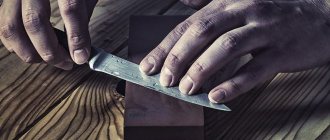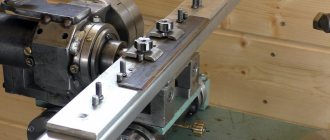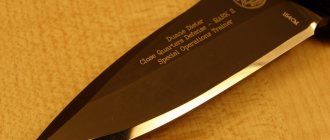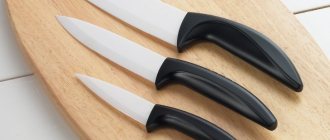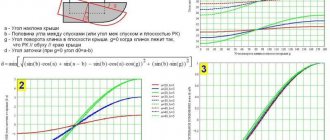- July 22, 2020
- Tools and equipment
- Andrey Sky
Almost any knife, especially for household use, requires regular restoration of the cutting edge. Due to constant mechanical impact, the tip becomes dull and deformed, which is why its performance is lost. Therefore, the sharpening process is a mandatory technological operation as part of the maintenance of this tool. This procedure can be performed with makeshift tools, but it is much more convenient to use special equipment like a sharpening machine. How to sharpen knives correctly on such a unit? Several aspects of the operation need to be taken into account at once - this applies to preparatory work and setting up equipment in compliance with safety rules.
When is it necessary to sharpen a knife?
If the tool is in good condition and fully ready for cutting operations, there is no point in adjusting its edge. On the contrary, performing this procedure may disrupt the initially correct edge geometry and reduce the quality of the cut.
But there are signs that clearly indicate that the use of an electric knife sharpener or other tool is required to restore the tip to working condition. For example, if small particles of metal are chipped off the edge. Some models of knives, depending on the material used, even pose a risk of injury in a dull state.
Another sign of a non-ideal state of the tip is the poor quality of the cut in principle. If the knife does not cut, but tears the product, it is necessary to correct it. The essence of the sharpening operation will be to restore the desired blade profile. In other words, the rounded edge of the tip must be given the shape of a cone.
Rules of use and care
A sharp knife is safer than a dull one. It has a smaller area of contact with the object and, at the same pressure, is less likely to jump off it. Therefore, it is more difficult for them to get hurt. The knife will cut into an object without effort if you keep the blade sharp, protecting it from cutting hard materials. The cutting board should be made of wood or plastic. After work, the cutting tool is rinsed or washed using non-aggressive household chemicals and wiped dry. Knives should not be stored “in bulk” with other metal products; ideally, a separate box or special stand would be suitable.
Use wooden or plastic cutting boards
For storage you should use special boxes
Wash with warm water and non-aggressive detergents
How to choose a sharpening machine?
For household work, it is best to use electric models for household use. Today these are universal units with a desktop installation method that cope with the restoration of blades not only of knives, but also of axes, chisels, all kinds of cutters and scissors.
It is advisable to give preference to knife sharpening machines with an adjustable angle, which will initially improve the quality of the operation. Moreover, it is important to pay attention to the configuration of the working equipment. Firstly, much more sharpening capabilities will be provided by a machine that allows the use of an abrasive disc and tape. Secondly, it is more convenient to use a setup with two circles on different sides. The fact is that the process of point correction may require the use of abrasives with different degrees of grain size. To avoid wasting time on reinstalling them when moving from one circle to another, it makes sense to take care in advance about the possibility of installing two elements simultaneously from different sides.
Why does the blade become dull?
There are a number of factors that influence the process of dulling a cutting edge:
- Excessive force transmitted to the tool when cutting. This causes the blade to bend.
- Incorrect turning process.
- Cutting hard materials.
- Improper storage.
- Impacts against metal objects.
- Destruction of metal due to corrosion.
Blacksmiths do not recommend washing knives under hot water. This is due to the fact that the metal is affected by aggressive salts, which reduce the sharpness.
Features of professional sharpening machines
Such equipment has several technical and operational differences from household analogues. But it’s worth emphasizing right away that the cost of this machine can be 2-3 times higher than models for home use.
So, we are talking about more productive, functional and precise units that can confidently adjust the shape of an edge made of tool and high-speed steel. As a rule, professional electric knife sharpeners have a durable metal base, a balanced rotor, almost always the ability to install two wheels, and a powerful three-phase motor.
In terms of functionality, it is worth emphasizing the possibility of adjusting the reach, point-by-point adjustment to the dimensions of the tool being processed, and automatic wetting of the working equipment, which protects it from overheating.
Electric sharpeners
Electric sharpeners are a modern alternative to whetstones and whetstones. These devices can be adjusted to suit different types of blades. The knife is guaranteed not to be damaged. Sharpening one product, often together with grinding, takes up to 2-3 minutes.
Electric sharpeners differ in power levels and additional equipment. The most expensive and professional sharpeners are equipped with three grooves with different disks. They provide a three-step process and not only sharpen the cutting edge, but also polish it.
An expensive tool is necessary when you need to sharpen ceramic and exclusive products made from elite materials. Ceramic kitchen knives have become popular, but they are difficult to sharpen without preparation. There is a risk of crumbling and deforming the cutting part.
The best manufacturers of sharpening machines
In the budget segment, for simple sharpening tasks you can find good offers from domestic manufacturers. These are machines costing up to 3-4 thousand rubles. from brands such as “Vikhr”, “Kraton”, “Caliber”, etc.
The middle and most popular segment is represented by models with a price tag of approximately 5 to 10 thousand from Bosch, Metabo and Makita. According to reviews, one of the best knife sharpening machines in this group is the Bosch GBG 60-20 model. It has balanced characteristics and decent German workmanship.
Private craftsmen and industrial workers will be interested in professional models. This is a narrow, but technologically developing class of sharpening machines from companies such as Inforce and Proma in the BKL line.
Abrasive wheel selection options
This consumable material for a processing machine is available in a wide range. The sharpening wheel specifically for a knife should be designed for working with steel and the possibility of finishing correction.
The shape of the profile is fundamentally important for working with sharpening. In this case, equipment with a straight profile is used, which is optimal for straightening the blade.
The grit size will determine what type of finish a particular abrasive wheel can provide. For a sharpening machine used to correct a knife blade, almost all types of fractions can be used. Usually there are three ranges - from 400 microns, from 1000 microns and from 5000 microns. Accordingly, coarse, medium and fine sharpening is provided. Sometimes you can limit yourself to just finishing touches if the blade requires only minor editing.
The type of abrasive itself is equally important. Although knives are not overly demanding tools in terms of machining and dressing, today it is better to give preference to the more durable and efficient alumina blades. This material is hard and resistant to damage.
How to check the grinding wheel?
Whatever wheel is used in the work, it must be carefully checked before performing the operation. The audit must begin with a visual inspection. The item should not have the slightest crack or even chip.
Next, a check is performed on the machine. For this procedure, it is better to use a professional knife sharpening machine, which provides more effective safety features and customization options. On it, in particular, it will be possible to check the abrasive wheel for runout. This defect is expressed in vibrations, when, upon external observation, the outer edge of the disk moves away from the center to the sides. If such a flaw occurs, then the abrasive will need to be corrected with a special diamond device.
Let's summarize?
At this point, the sound track ended as expected, Shufutinsky stopped warming up his baritone, the characteristic hiss of the record was heard, and now all the sharp objects in the house are in perfect condition...
So what should you remember when starting sharpening?
- Let's decide on a goal.
- Choosing the right type of sharpening machine.
- We make a choice in favor of the most convenient type of sharpening for us.
- We handle the unit carefully, otherwise it may become damaged or break, and this applies not only to the sharpening process, but also to handling kitchen utensils in general.
- Remember about the angle of inclination when sharpening.
- We sharpen ceramic products no more than twice a year, or even less! If the presented conditions are met, ceramic knives will always be in excellent condition!
General sharpening technology
First of all, you need to consider the operation from the outside. It is usually performed in two stages.
Initially, a smooth edge of the chamfer is formed so that it is sharp and without external defects. We can say that this is a rough sharpening, during which the general geometry of a sharp blade is simulated without the previous roundness. At this stage, wheels with a large grain fraction can be used.
The second stage involves performing a much more important operation to restore the blade. How to properly sharpen knives on a sharpening machine as part of the finishing edit? Much will depend on the experience of the performer, but in any case, you should focus on the existing shape of the blade, which was modeled during rough processing. At this stage, small irregularities and burrs are usually removed that cannot be carefully removed with large-format abrasive.
Technique for sharpening knives on a machine
Now you can move on to the most important stage - direct work with the knife.
It is advisable to position the blade against the direction of movement of the disk, which will prevent the metal from crumbling at the edge and minimize the risk of the same burrs forming. The only disadvantage of this method of positioning the knife is the risk of cutting it into a circle, which will ruin the tip at one point and may well deform the entire knife. Therefore, at first, beginners can experiment with positioning the knife in the direction of the abrasive stroke.
At the editing stage, additional devices will be required for sharpening the knife on a sharpening machine. We are talking about a whetstone with the finest grain, which will allow you to carefully trim the edge in certain areas. The process of fine-grained sharpening on a machine should be performed with a minimum number of movements. There is a high risk of knocking down a chamfer, which will ruin the entire result. You need to act carefully and balanced - along the entire length of the blade. Both sides are processed in this way so that the shiny surface of the knife is equally visible.
Types of wear
Typically, the technology of how to properly sharpen kitchen knives is a set of measures consisting of coarse and fine sharpening with possible subsequent polishing if the material of the tool allows the sharpness to be increased by the final procedure. For high-quality steels, before a noticeable loss of cutting properties, the tool is capable of making 200–500 cuts on food products and maintaining an acceptable sharpness for a long time after that.
Intervention in the edge geometry may only be necessary in case of severe wear once every few years, except in emergency cases. The main damage that leads to the need to remove large amounts of metal with abrasives occurs mainly when using the blade as a lever. Such stress can even cause the blade to bend or break.
Great forces on hard objects are no less destructive to the knife. Attempts to cut ice, bones, or accidentally hitting the side of the pan lead to chipped edges. The fabric can also be damaged as a result of severe corrosion, usually from exposure to food acids or from high temperatures and aggressive chemicals in the dishwasher. The corrosion pits that form on the edge require its complete restoration.
To avoid such damage, you should follow simple rules:
- use tools appropriate to the task;
- use only wooden surfaces as boards;
- cut without lateral movements;
- wash the blade immediately after use;
- Keep each separately clean and dry.
What is the correct knife sharpening angle?
The value is not universal, so you should focus on the specific type of knife and its application. It can be said that in the first stage of rough modeling of the geometry, some metal should be left for later removal for straightening purposes. When final sharpening knives, the angle is usually kept in the range from 7° to 45°. Moreover, average values of about 25° usually apply to kitchen tools, and the upper bar, up to 50°, applies to special models for tourist and hunting purposes.
About angles
Holding a knife at the desired angle while sharpening is not as easy as it might seem at first glance. And what is this corner like? For the vast majority of the inexpensive knives mentioned above, the sharpening angle is 20-30 degrees. There are many ways to “calculate with your hands” the desired tilt of the blade; The simplest one is to fold a sheet of thick paper into a triangle, one fold is 45 degrees, the second is half as much, 22.5. We place the resulting pyramid on the block, carefully press the blade against it and remember the tilt and position of the hands.
20-25 degrees is a good angle for a well-worn carbon OpinelFor the same purposes, you can use special wooden corners or several coins glued with superglue. Or simply buy a special clip for the blade, which will prevent the edge from being too “collapsed”.
True, if the steel is completely “plasticine”, they try to increase the angle as much as thirty-five degrees - cutting such a product will be quite lousy, but it will take a long time. Here you can also play with a sheet of paper, but you will have to fold it not in four, but in three - as a result you will get a corner with a working side close to 33 degrees.
For soft steels there is another trick: the angle is maintained around 30 degrees, but one side of the cutting edge is smoothed almost “into a mirror”, and the other is sharpened on a rough, coarse-grained whetstone. This method is popularly called “gypsy”; at the industrial level, it degenerated into the notorious “laser-sharpened knives” (although, of course, there was no smell of laser there).
Small teeth on one side, a smooth surface on the other, and even the top layer of steel is carburized to increase hardness - it cuts well until it gets dull. For cheap domestic stainless steels such as 40X13, 65X13 or the favorite of Chinese manufacturers 420J2, this method works well - try it yourself.
Features of sharpening knives on a manual machine
Today there are many purely mechanical sharpening machines without an electric drive. They have a wide variety of design options and functionality. But when handling such a tool, it is important to consider several nuances. Firstly, a manual knife sharpener is usually mobile, which means that it will need to be well secured each time. This should be done on a workbench or other hard and stable table. Secondly, the sharpening process is performed with translational movements in only one direction. It should also be noted that with intensive use of manual sharpeners with a configuration of two V-directional abrasive stones, the knife will wear out much faster than when working with an electric machine.
What should you know about sharpening stones?
Comprehensive maintenance of knives, even if you have a machine with abrasive wheels, is unlikely to do without a touchstone. This granular block will allow, if necessary, to correct the result obtained on the machine, as well as support the operation of the tool in the field, if necessary.
In addition, some electric units are fully equipped with such bars as consumables. How to sharpen knives correctly on this type of sharpening machine? The principle is somewhat similar to mechanical and electrical machines on circles. The only difference is that the operator does not need to make any special efforts. The main work will be done by the device itself. The maximum that will need to be done is to ensure external control of the process.
Of course, a lot will depend on the sharpening stone itself. They are ceramic, abrasive and natural. If we are not talking about using the product as part of an electric machine, then before work it is better to moisten it with a soap solution. This technique will improve glide and prevent intense spraying of small particles from metal and abrasive.
Checking the sharpness
Using a professionally sharpened blade, they shave the hair on the arm and “plane” a sheet of paper suspended by the tip without catching. There is a test for kitchen knives: place a tomato on a stand and, without much effort, without holding anything, cut off half or a slice from it. You can also use your thumb to evaluate the sharpness of a specimen if you have some experience: you should run the pad across the blade; tactile sensations will not deceive the knife tester.
Paper
Checking shaving hair on the arm
Using a tomato
Safety requirements
Using a tool sharpening machine is a very reasonable and convenient way to solve the problem of dull blades. But we must not forget about safety. How to properly sharpen knives on a sharpening machine without harming your health? First of all, you can only work on proven and serviceable equipment, as well as on tested equipment, as already mentioned. During the operation, sudden manipulations and changes in the operating mode are excluded. All actions are performed smoothly and without jerking. Also, in the room where sharpening is carried out, there must be active ventilation. Small particles of abrasive and metal released during such operations must be removed immediately, as they pose a threat to the respiratory system.
